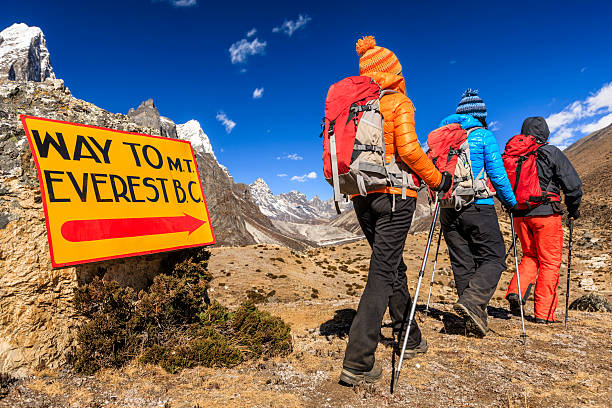Mount Everest, the world’s highest mountain, stands as a majestic giant in the heart of the Himalayas, attracting adventurers and trekkers from around the globe. One of the most iconic treks in the world, the journey to Everest Base Camp offers a unique blend of natural beauty, cultural experiences, and personal achievement. In this comprehensive guide, we will delve into all aspects of this incredible trek, from its difficulty level and the best time to visit, to the essential permits required and how to combat altitude sickness.
Everest Base Camp: The Gateway to The World’s Highest Mountain
Nestled in the shadow of Mount Everest, Everest Base Camp serves as the starting point for those daring enough to attempt the summit. Located at an altitude of over 5,300 meters, the Base Camp offers trekkers a glimpse into the world of high-altitude mountaineering and the chance to witness the awe-inspiring beauty of the surrounding peaks.
Everest Base Camp Trek Difficulty
The Everest Base Camp trek is considered a challenging adventure, suitable for those with a good level of fitness and some prior trekking experience. The trail is rugged and demanding, with steep ascents and descents, high altitudes, and unpredictable weather conditions. However, with proper preparation and training, trekkers of all ages can successfully complete the journey.
The Best Time to Trek to Everest Base Camp
The ideal time to trek to Everest Base Camp is during the pre-monsoon (spring) and post-monsoon (autumn) seasons, which typically fall between March to May and September to November, respectively. These months offer stable weather conditions, clear skies, and moderate temperatures, providing trekkers with the best chance to enjoy the stunning mountain views and comfortable trekking conditions.
The People Who Make The Trek to Everest Base Camp Possible: The Sherpas
No discussion of Everest Base Camp would be complete without mentioning the Sherpas, the legendary mountain guides and porters who play a crucial role in making the trek possible. Known for their strength, resilience, and deep connection to the mountains, Sherpas are an integral part of the Everest region’s community and culture, providing invaluable support to trekkers and climbers alike.
Everest Base Camp Trek Itinerary
A typical 12 Days Everest Base Camp trek itinerary spans around 12-14 days, starting from Lukla and passing through picturesque Sherpa villages, dense forests, glacial rivers, and high mountain passes before reaching the Base Camp. Along the way, trekkers have the opportunity to acclimatize to the altitude, immerse themselves in the local culture, and marvel at the breathtaking landscapes that unfold before them.
Everest Base Camp With Helicopter Return
For those seeking a more luxurious and time-efficient option, the Everest Base Camp trek with a helicopter return offers a unique opportunity to experience the beauty of the Himalayas from a different perspective. This premium package combines the thrill of trekking to Base Camp with the convenience of a scenic helicopter flight back to Kathmandu, providing trekkers with a once-in-a-lifetime experience.
Where Can I Find A Map For The Everest Base Camp Trek?
Maps and guidebooks for the Everest Base Camp trek are readily available in Kathmandu, Lukla, and other major trekking hubs in Nepal. Additionally, numerous online resources and mobile apps offer detailed maps, route descriptions, and essential information to help trekkers navigate the trail with ease.
What Permits Do I Need For The Everest Base Camp Trek?
To undertake the Everest Base Camp trek, trekkers are required to obtain two permits: the Sagarmatha National Park Entry Permit and the Khumbu Pasang Lhamu Rural Municipality Entry Permit. These permits help fund conservation efforts, support local communities, and ensure the safety and well-being of trekkers in the region.
The Tea Houses on The Everest Base Camp Trek
Accommodation along the Everest Base Camp trek is primarily in tea houses, traditional lodges that offer basic amenities such as simple rooms, communal dining areas, and hearty meals. Staying in tea houses provides trekkers with a comfortable and authentic Himalayan experience, allowing them to rest and recharge after a day of trekking amidst stunning mountain scenery.
Everest Base Camp and Altitude Sickness
Altitude sickness, also known as Acute Mountain Sickness (AMS), is a common concern for trekkers ascending to high altitudes such as Everest Base Camp. To minimize the risk of AMS, it is essential to acclimatize properly, stay hydrated, and be aware of the symptoms of altitude sickness. Trekkers should also consult with their guides and be prepared to descend if necessary to ensure their safety and well-being.
Packing List for the Everest Base Camp Trek
Packing for the Everest Base Camp trek requires careful consideration of essential gear and clothing to ensure comfort and safety throughout the journey. Some key items to include in your packing list are sturdy hiking boots, warm layers, a good quality sleeping bag, trekking poles, and a first aid kit. It is also important to pack light and carry only the necessities to avoid unnecessary weight on the trail.
Where Can I Book the Everest Base Camp Trek?
Numerous trekking agencies in Kathmandu, Lukla, and Namche Bazaar offer guided Everest Base Camp treks, providing trekkers with experienced guides, porters, and logistical support to make their journey safe and enjoyable. Additionally, online booking platforms and travel agencies can help arrange customized trekking packages tailored to individual preferences and requirements.
Embarking on the Everest Base Camp trek is a life-changing experience that promises adventure, inspiration, and a deep connection to the natural world. Whether you choose to trek independently or with a guided group, the journey to the roof of the world will leave you with memories to last a lifetime and a newfound appreciation for the beauty and majesty of the Himalayas. So lace up your boots, pack your bags, and get ready to embark on an unforgettable trek to Everest Base Camp, where the journey is as rewarding as the destination itself

